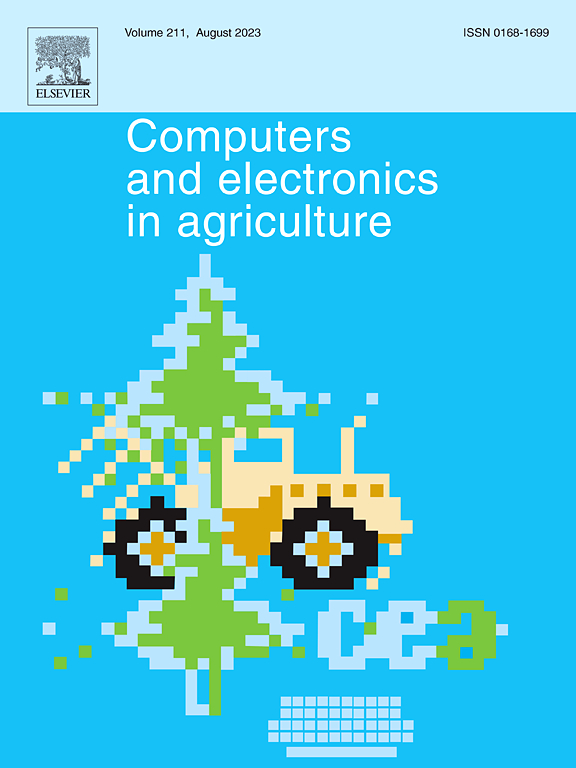牛伙伴网:一种肉牛体型关键区域识别方法及其在肉牛体型测量中的应用
IF 8.9
1区 农林科学
Q1 AGRICULTURE, MULTIDISCIPLINARY
引用次数: 0
摘要
为了解决人工测量肉牛身体尺寸带来的挑战、诱导动物应激反应的可能性以及这种劳动密集型任务固有的低效率问题,提出了一种新的三维(3D)基于点的深度学习(DL)网络,名为catlepartnet。这个创新的网络被重新设计,将牛的点云数据(PCD)分割到关键的身体区域,从而促进和优化测量过程。新提出的catlepartnet采用PointNet++的基网作为骨干网,其中新加入了并行化的斑块感知关注模块和深度可分卷积,以降低过拟合的风险。此外,它还集成了Sophia优化器,这是一种新颖高效的优化算法,而不是pointnet++中的Adam优化器。令人印象深刻的是,正如ShapeNetPart数据集所证明的那样,CattlePartNet比pointnet++骨干网的平均交联(mIoU)提高了2.4%,ShapeNetPart数据集被广泛认为是PCD分析领域零件分割任务的既定基准。利用已建立的网络,catlepartnet在牛PCD数据集上进行训练,自动分割关键身体区域,实现了令人印象深刻的91.7%的mIoU。牛的体型分为线性和曲线两种。对于线性体型:身体高度(BH)、身体长度(BL)和臀部高度(HH),使用复杂的轮廓提取技术(如Alpha shape、平均曲率和高斯曲率)识别和提取测量点。曲线体型:胸围(CG)和腹围(AC)通过切片截取和三次b样条曲线法测量。5种体型(bh、BL、CG、AC和hh)的平均相对误差分别为4.96%、5.47%、6.04%、5.68%和5.49%。与传统的肉牛测量方法相比,CattlePartNet精确地从PCD中提取出身体大小的关键区域,证明了在不同牛品种的一般分割方面的稳健性,并显示了在其他大型牲畜物种的PCD分割方面的潜力。此外,5种体尺的测量算法精确定位了每个区域内的关键测量点,为健康评估和生产性能测量等育种应用提供了必要的支持。本文章由计算机程序翻译,如有差异,请以英文原文为准。
CattlePartNet: An identification approach for key region of body size and its application on body measurement of beef cattle
Addressing the challenges associated with manual measurement of body sizes for beef cattle, the potential for inducing stress responses in animals, and the inefficiencies inherent in such labor-intensive tasks, a novel three-dimensional (3D) point-based deep learning (DL) network named CattlePartNet is proposed. This innovative network is redesigned to segment point cloud data (PCD) of cattle into crucial body regions, thereby facilitating and optimizing the measurement process. The newly proposed CattlePartNet adopts the base network of PointNet++ as its backbone network, where the parallelized patch-aware attention module and depth-wise separable convolutions are freshly incorporated to lower the risk of overfitting. Additionally, it incorporates the Sophia optimizer, a novel and highly efficient optimization algorithm, instead of the Adam optimizer in PointNet++. Impressively, CattlePartNet outperforms the PointNet++ backbone network with a 2.4 % improvement in mean Intersection over Union (mIoU), as demonstrated on the ShapeNetPart dataset, which is widely regarded as an established benchmark for part segmentation tasks within the domain of PCD analysis. Leveraging the established network, CattlePartNet is trained on a dataset of cattle PCD for automated segmentation of key body regions, achieving an impressive mIoU of 91.7 %. The body sizes of cattle are categorized into two types: linear and curvilinear. For linear body sizes: body height (BH), body length (BL), and hip height (HH), measurement points are identified and extracted using sophisticated contour extraction techniques such as Alpha Shapes, mean curvature, and Gaussian curvature. Curvilinear body sizes: chest girth (CG) and abdominal circumference (AC) are measured through slice interception and cubic B-spline curve methods. The mean relative errors for the 5 body sizes—BH, BL, CG, AC, and HH—are reported as 4.96 %, 5.47 %, 6.04 %, 5.68 %, and 5.49 %, respectively. In comparison to traditional measurement of beef cattle, CattlePartNet precisely extracts key regions of body size from PCD, demonstrating robustness in generalizing segmentation across diverse cattle breeds and showing potential for segmenting PCD of other large livestock species. Furthermore, the measurement algorithm of 5 body sizes accurately localizes key measurement points within each region, providing essential support for breeding applications such as health assessment and production performance measurement.
求助全文
通过发布文献求助,成功后即可免费获取论文全文。
去求助
来源期刊

Computers and Electronics in Agriculture
工程技术-计算机:跨学科应用
CiteScore
15.30
自引率
14.50%
发文量
800
审稿时长
62 days
期刊介绍:
Computers and Electronics in Agriculture provides international coverage of advancements in computer hardware, software, electronic instrumentation, and control systems applied to agricultural challenges. Encompassing agronomy, horticulture, forestry, aquaculture, and animal farming, the journal publishes original papers, reviews, and applications notes. It explores the use of computers and electronics in plant or animal agricultural production, covering topics like agricultural soils, water, pests, controlled environments, and waste. The scope extends to on-farm post-harvest operations and relevant technologies, including artificial intelligence, sensors, machine vision, robotics, networking, and simulation modeling. Its companion journal, Smart Agricultural Technology, continues the focus on smart applications in production agriculture.
 求助内容:
求助内容: 应助结果提醒方式:
应助结果提醒方式:


